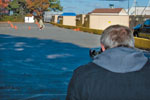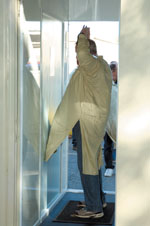Putting the Plug into Person-borne Bombs
 |
| Mike Nolan (foreground), a business development manager for a private contractor participating in counter-improvised explosive device (IED) testing, uses infrared technology to look for simulated IEDs being carried by test subjects at Hanscom Air Force Base (AFB), Massachusetts, October 23, 2008. The tests being conducted by the Air Force Irregular Warfare/IED Defeat Program Office at Hanscom are expected to pinpoint technologies that can reduce suicide bombing threats in theater. |
The U.S Air Force is coming out of the sky to counter some serious threats on the ground. Working with its land-based counterparts, the service rapidly implemented a process to evaluate technologies valuable for defeating certain explosive devices in an attempt to stop the weapons from harming more troops and civilians in the
The research and development efforts came to life last August when the Joint Improvised Explosive Device Defeat Organization (JIEDDO) asked the Air Force’s Electronic Systems Center (ESC) at Hanscom Air Force Base (AFB),
Each contractor team had a four-hour time frame to showcase its technologies through the precise testing protocol put in place by the ESC’s U.S. Air Force Irregular Warfare/IED Defeat Program Office. Evaluators judged for two major criteria: probability of detection and false alarm rate. They established an entry control point scenario, allowing the contractors to place their system at one end of the testing area and attempt to detect the explosives from as far away as possible. The tests involved 100 people divided into groups of 10.
In each group, seven people wore test devices that simulated explosives found in theater, and three wore blanks; all wore loose-fitting garments to simulate the common dress of people in
Technologies were judged for their ability to detect devices accurately with a minimum of false positives. Ed Mason, division chief of the Air Force Irregular Warfare/IED Defeat Program Office, explains that ensuring detections are legitimate is critical for success. Otherwise, he says, “It’s like flipping a coin.” In addition to determining accurate readings, Mason and his team evaluated throughput time for processing the individuals. The experts want to see quick detections, because causing a queue to form gives suicide bombers another place to attack people. In actual in-theater operations, if an individual were found to be wearing a device, he or she would be separated from the crowd and asked to remove outer clothing for further inspection from a safe distance. Mason says the last thing anyone wants is for the bomber to get close to a gate with soldiers and then detonate the bomb. The farther out the detection can reach, the more easily troops can segregate the enemy.
Also evaluated were the setup times of systems and the complexity of preparing each one for action. Mason says evaluators looked at how many people it took to set up the system and for how long; how it was delivered to its place of operation; if a sergeant with minimal knowledge could set up the technology; and if there was automatic detection or whether a person had to be removed from another mission to look at a computer screen for the results. “If you look at a computer screen long enough, you kind of go batty,” Mason says.
Each of the nine systems was evaluated on the same criteria, and program office personnel provided recommendations to the contractors at the end of the process. To pick the original nine technologies evaluated, the program office did a data call and looked at the data available in military laboratories. They also looked at industry and found some solutions. After the office matched up the top 10 requirements in theater, the personnel looked at small innovative businesses to see if any prior work had been started that made sense to resurrect based on defined needs.
Last November, the program office personnel sent a 90-page report of the systems it had tested and evaluated, including pictures of the devices, probability of detection and false alarm rates as well as set-up logistics, size and weight to JIEDDO for that organization to determine what capabilities it may want to explore further and fund. Though Mason cited security reasons for declining to elaborate on the results of any particular system, he did say that when JIEDDO officials analyze the report and determine to move forward with any technical development, then his team could conduct more rigorous capabilities and limitation testing at sophisticated test environments such as White Sands Missile Range, New Mexico, or Eglin AFB, Florida.
Though the inaugural testing is complete, the PBIED effort is far from over. At the end of 2008, Mason and his colleagues were developing a financial package that would involve a two-year commitment to the work from their office. Testing will be conducted quarterly, and officials expect to have only a few technologies to evaluate each time. The nine systems available for evaluation last fall resulted from a backlog caused because testing had not been conducted previously.
Despite the speed with which Hanscom personnel were able to set up the tests and evaluations, the military was not able to field any of the counter-PBIED technologies tested for the Iraqi elections because of the systems’ complexities and states of readiness. As the process unfurled, officials realized the systems were too costly and the lead times too extreme to have a viable solution in place in time. In fact, many systems were still in the prototype phase. However, the Air Force Irregular Warfare/IED Defeat Program Office was able to assist JIEDDO with sending over some necessary detection technology. The military still needed some sort of detection device to help secure the election proceedings, so JIEDDO asked Mason’s office to buy as many metal detectors as possible and have them in country by the necessary date.
 |
| A member of a team participating in counter-IED testing at Hanscom AFB last fall is scanned by a system that uses X-ray backscatter technology to detect person-borne improvised explosive devices (PBIEDs). |
Mason explains that JIEDDO came to the ESC for these types of projects because it is an acquisition center and understands how to conduct the market research and procure the right technologies. Also, before his unit became the Air Force Irregular Warfare/IED Defeat Program Office, it was stood up as the Air Force Counter IED Office in 2005. “This is right up what we were doing,” Mason shares. He continues that some people question why the Air Force is involved in an IED fight when the service’s main role is air power. The answer, he says, is that IEDs are a joint fight and airmen are out there as well. Plus, the Air Force office’s work with the Joint IED Task Force, which is an Army unit, and with JIEDDO puts them in contact with more traditional ground troops—soldiers and Marines—and the “guys on the ground” make the decision about what they want.
Besides the work on PBIEDs being conducted for JIEDDO, Mason’s office is looking at other projects in the science and technology realm, such as maturing cutting-edge ideas. “We try to match technologies to anything warfighters need,” Mason explains. In the area of IEDs, the office works more on finding the explosives rather than neutralizing them, which is a matter for explosive ordnance disposal personnel. The Air Force office detects the weapons using various intelligence, surveillance and reconnaissance technologies such as database queries and turning data into information. The work involves hardware and software solutions.
Mason explains that PBIEDs have come to the forefront recently because the military has done such a good job with crew systems jamming IEDs on the roadside that more individuals are attacking with suicide bombs. “It’s become the weapon of choice as of late,” Mason says.
Managing IEDS in general is problematic because, as Mason explains, as soon as
The deadliness and changing nature of the weapons pose a constant threat to warfighters and civilians, and PBIEDs continue to cause death and injury. “Look at the paper every morning,” Mason states. “See how many suicide bomber attacks there are daily.” Not only are these terrorists targeting soldiers on patrol, but Iraqi police stations as well. Eventually, the stand-off technologies being evaluated by the Air Force Irregular Warfare/IED Defeat Program Office could be set up at a location such as that, as well as at other entry control locations.
Though the thrust for the recent effort grew out of the need for PBIED technologies for the Iraqi elections in January, Mason believes that as the deadly devices move to Afghanistan and the defeat technology matures, it could be used in that country. In addition, the U.S. Department of Homeland Security has expressed interest in the technology, so there could be stateside applications. Companies interested in having their PBIED solutions evaluated can apply or express their interest in several ways. They can contact the Air Force Irregular Warfare/IED Defeat Program Office directly, or they can contact the JIEDDO Ground Branch. A broad area announcement also has been released and will be out for the next two years explaining what evaluators are looking for from different IED technologies.
Web Resources
Joint Improvised Explosive Device Defeat Organization: https://www.jieddo.dod.mil




Comments